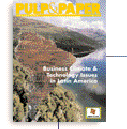|

Donald I. Lunde is an industry consultant and president of Market Opportunity Resources.
|

THE CHALLENGE OF LASER PAPERS
Paper mills continue to be challenged to provide products that will meet all requirements of the increasingly fast and complex laser printing equipment. Developments such as color printing are placing added demands on the paper, which in many cases require changes in papermaking chemical and pigment application. Thus, the proper choice of filler pigments, retention aids, starches, and other chemical additives is critical to meeting customer needs in uncoated free-sheet, the most common paper used.
PAPER ASKED TO DO MORE. Laser copying and printing has changed dramatically during the past several decades. Papers designed for use in this equipment have also changed very significantly and continue to be improved. They are expected to provide trouble-free performance in the new, faster printers where the paper path is often tortuous to accommodate both printing and complete document production.
The papers must be capable of handling black and white toner printing, as well as the newer four-color toner printing technologies available today. In addition, there is a trend to combine variable laser printing with conventional printing—usually offset lithography—involving tacky inks and aqueous fountain solutions. This further increases the challenge to mills trying to balance all paper performance properties.
Color laser printing is one segment of the overall huge laser printing market that is growing rapidly. The current color laser printing market is estimated at about 197,000 tons this year. The total digital printer market is currently an estimated 629,000 ton annual market. Color laser printing is projected to reach 900,000 tons in 2003, while the digital market expands to almost 2 million tons, according to the Information Management Institute. To provide for better print quality, color toner particles have recently been made smaller—down to about five microns, the minimum possible while avoiding a toner cloud in the printing equipment. The pore size of the paper surface then becomes critical. If too large, the new color toner particles can be lost into the paper pores. If too small, toner adhesion, oil absorption (for contact toner fusion printers), and offset printability may be hurt.
Paper surface pore size is influenced by the choice of wood fibers, filler pigments, and surface sizing ingredients, especially if the surface size is pigmented. Choice of filler and size press pigments will involve particle shape, particle size, and particle size distribution. Narrow particle size distribution is usually best for consistent control of pore size, as well as optical properties. A blend of different particle size pigments, perhaps even different shapes, may help optimize final paper surface pore size and maintain it uniformly for consistent printability. Of course, it is not all dependent on pigments or additives; good paper formation is a must.
PROBLEMS AT THE PRINTER. Papers for laser printing must also be conductive to attract the toners. Paper mills commonly add salt for this purpose. However, one major printer manufacturer has reported evidence that some mills may add too much salt, resulting in toner misplacement and missing dots. This hurts image quality. Once again, a balance is required.
Another common complaint is dusting. Paper dust can build up in laser printing equipment, requiring frequent maintenance. As mills increase filler level for improved optical properties and print performance at equal or lower cost, they have found it increasingly important to use microparticle retention aids to retain the fillers.
In addition, it is critical to add enough high quality modified starch or starch copolymer to hold the fillers in when the paper is slit or abraded by printer components, minimizing dusting problems. These starch products also assist in toner adhesion, a property aided by a binder such as SMA or styrene-acrylate polymer in the size press, as well.
Of course, paper surface pore size is also critical in coated papers. It is somewhat easier to control through proper coating formulation, application, and finishing. However, base paper properties are also very important, including good formation and coating holdout. An intermediate coating or pigmented size press treatment may also help.
Opportunities for new and improved papers continue to emerge as technologies change in the digital printing world. The challenge is for the paper mills to address the new needs successfully while maintaining other standard paper requirements. Many suppliers of pigments, binders, and additives stand ready to help in this regard.

|




